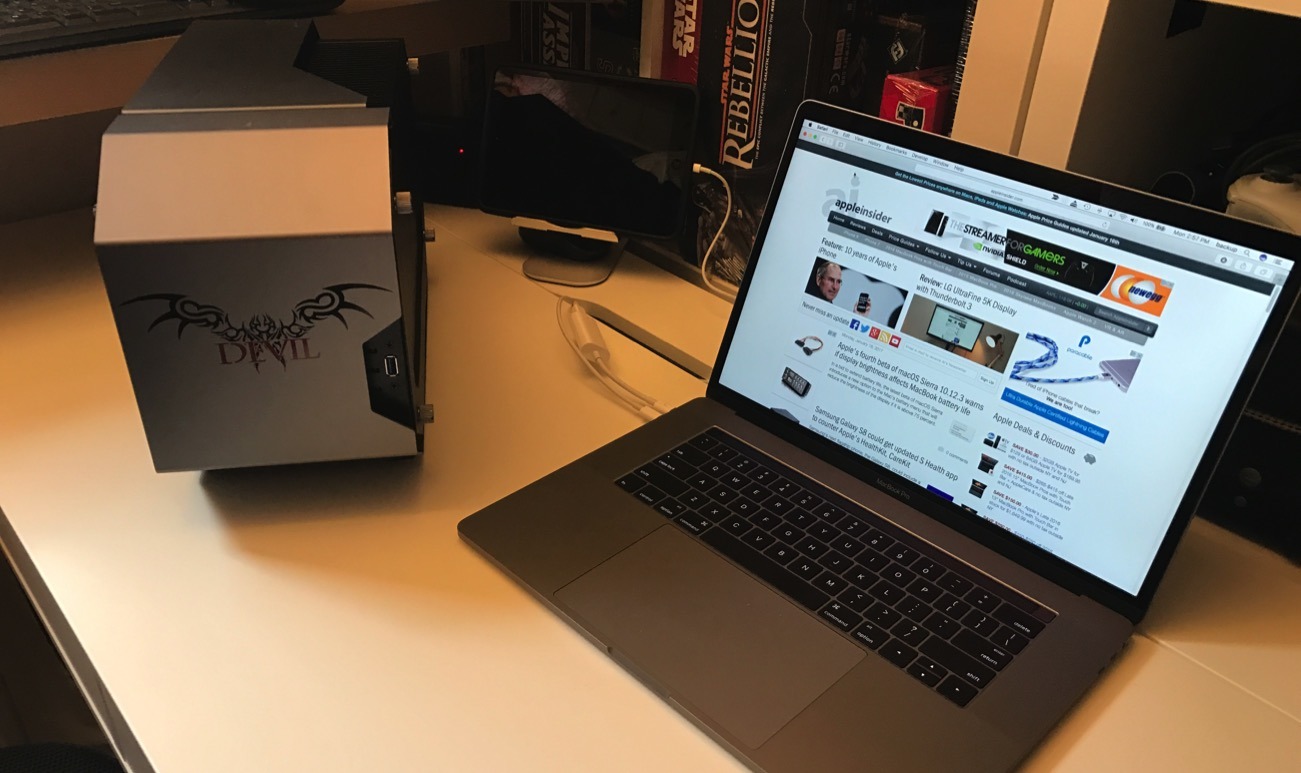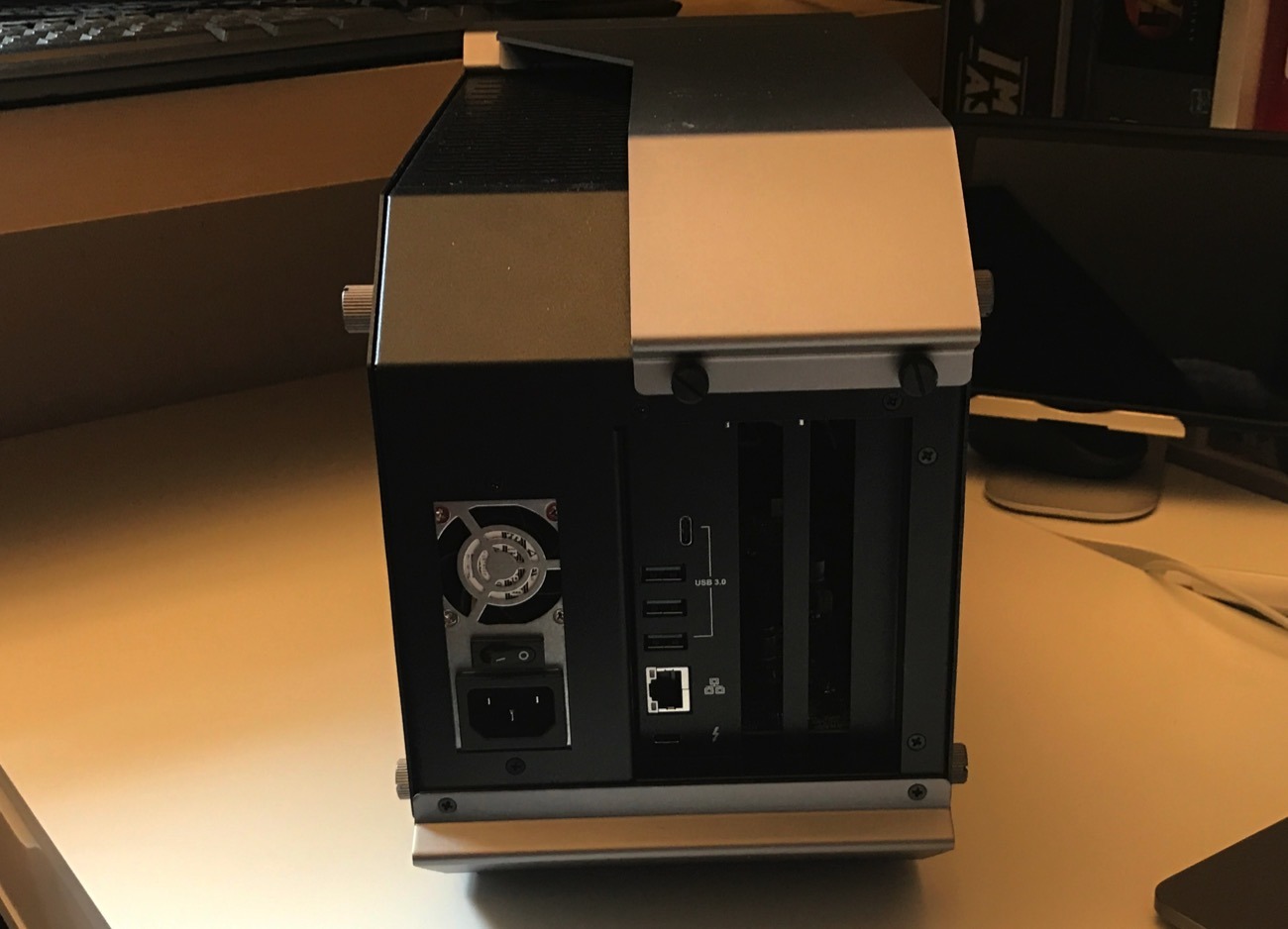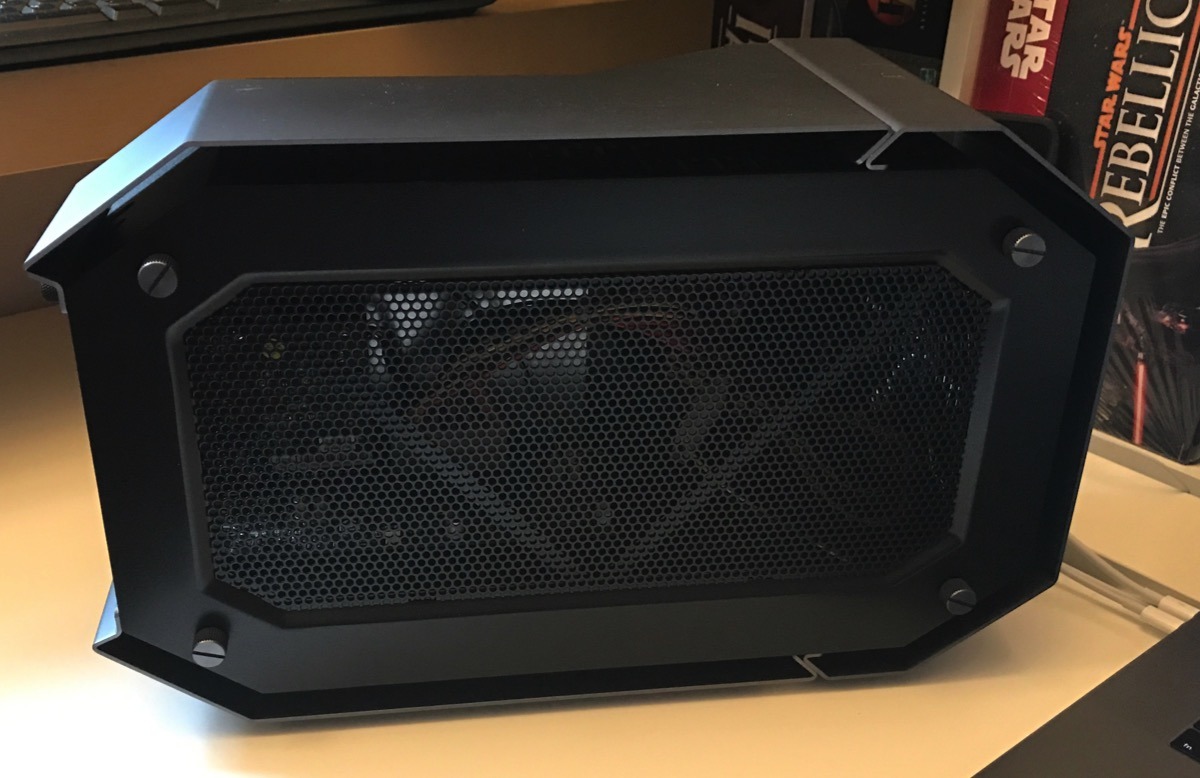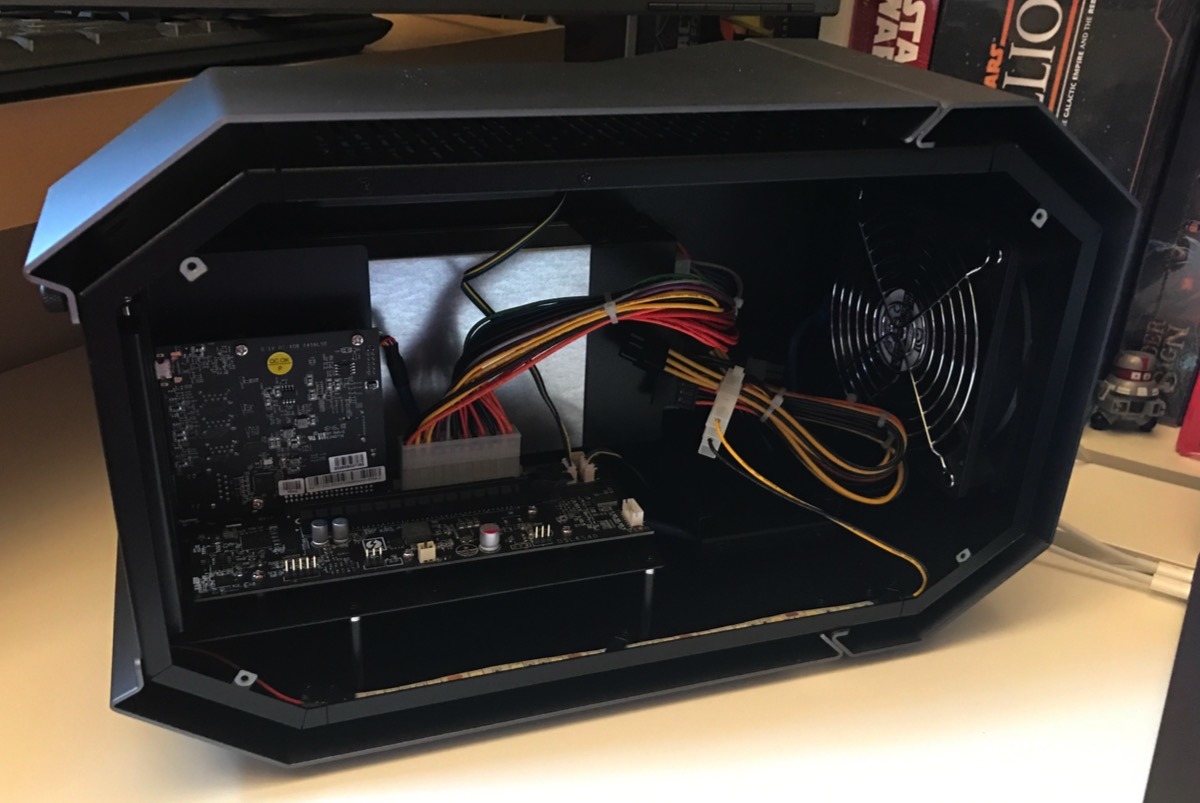PowerColor's Thunderbolt 3 Devil Box is the easiest way to get an external GPU on the MacBook Pro
New third-party hardware releases make the external GPU situation for macOS both less expensive, and slightly less "hacky" to install. AppleInsider examines the PowerColor Devil Box — so far the best way to get your MacBook Pro to Mac Pro tower GPU speeds and even give older hardware a significant boost without doling out the cash for a new computer.
As we've mentioned before, the Thunderbolt protocol nearly from release suggested that an external enclosure could be used to install an external graphics card, boosting performance on connected hardware.
Despite some amazing efforts from valiant third parties, it wasn't until Thunderbolt 3 that the bandwidth of the protocol fully caught up with the idea. Realizing this, the group responsible for the spec created implementations with the possibility of some configurations being able to pass the video signal back to the computer it was boosting.
While the pass-back isn't possible on macOS, using an external GPU to accelerate video on an external screen is.
Perhaps Apple will take notice of the Devil Box and similar solutions, and make the process easier for adopters.
The first iterations of this technology were very, very expensive, and required some hacks to pull off. More recent versions of the external enclosures require fewer, and simpler hacks, plus are cheaper and more compatible with macOS.
Enter, the Devil Box
The $379 PowerColor Devil box clearly didn't spring from Jony Ive's design lab. It isn't simply styled, and adopts much of the design aesthetic from customized gaming PCs. Besides adornments including the gaudy case lighting, there is a single USB-A port on the front, and room for a two-slot wide video card and 2.5-inch drive inside.
The back of the case has three more USB 3.0 type-A ports, a Gigabit Ethernet port, a USB 3.1 generation 1 type-C port, and the Thunderbolt 3 input. Video outputs are dependent on which video card you choose to install.
No matter what you pick as a GPU for the enclosure, be mindful of the card's physical size. While the Devil box is spacious, it still will only accommodate a card 310 mm long, 140 mm high, and 50mm deep.
The case is heavy, and large. If you want to keep a minimalist desk, you may need to buy a longer Thunderbolt 3 cable and put the enclosure on the floor.
Setup
Our test Mac is a 15-inch MacBook Pro with 2.9 gigahertz quad-core processor, 512GB SSD, and the Radeon Pro 460 GPU. Connected to it is the PowerColor Devil Box.
Out of the box, with no drivers, the USB 3.0 type A and 3.1 type C gen 1 ports work, as does the Gigabit Ethernet port.
To get an external PCI-E GPU working inside the Devil Box with macOS, you have to disable system integrity protection, as well as run a script for automated installation of the drivers, and some other system modifications.
If all you're going to do is game in Windows, then there's no need to install anything in macOS.
The performance is astounding
We tested several Nvidia cards with the Devil Box, and we got essentially the same numbers that we did for the earlier test with the Razer Core.
In macOS, the Nvidia GTX 980 managed 4.8 teraflops, with the two-year-old Nvidia 770 pulled down 3.1 teraflops. In Windows, the same cards came in at 4.85 and 3.4 teraflops respectively.
In Windows, the Nvidia 1070 managed 6.4 teraflops, and the 1080 pulled down 9.8 teraflops, but as a reminder, there are currently no macOS drivers for these cards.
All of our benchmarks for the GTX 980 remained the same in the less expensive PowerColor Devil Box versus the Razer Core.
Bigger and brighter, but quieter
The Devil Box has better airflow, and is quieter than the Razer Core partially as a result of its size. Fully stressed, the enclosure hit 64dBA at three feet from the case, versus 71 on the Razer Core. Idle, the Devil Box is 44dBA, with the Razer Core sitting at 49dBA
For comparison, A 2016 MacBook Pro under load is about 36dBA and about 31dBA idle or under light load.
The case lights are very, very bright and sufficient to illuminate a small office at night to a brightness suitable for reading. We strongly recommend that you disconnect the white Molex connector to the LED strips as seen in the above picture.
A note about power from the Devil Box
The Devil Box will provide 60W of power, unlike eGPU boxes that require the Thunderbolt 3 hack, like the Razer Core. However, the MacBook Pro prefers 85W.
There's no real problem here. With the MacBook Pro lid closed, and the Devil Box connected to an external display, the system even under load never exceeded the power that the Devil Box was supplying.
With the lid open, and the CPU's integrated graphics powering the MacBook Pro's screen, the battery still charges. If the laptop's screen shifts to the discrete Radeon Pro, then the battery does drain, but very slowly.
Inducing a worst-case situation, we forced he laptop's screen to the discrete GPU, loaded the CPU with a video transcode, and ran GPU-intensive benchmarking software on the external screen to test the 60W supply. We stopped our battery drain test after 20 hours, with 40% battery remaining.
Older gear, and external GPUs
Apple faced a lot of criticism for its CPU and GPU choices in the 2016 MacBook Pro. Many users have elected to stay with their older Retina MacBook Pro models because there isn't a giant difference in real-world performance.
Some life can be wrung out of older Retina-era hardware without having to buy a new computer. If you don't install a drive, keep data demands from the USB 3.0 ports low, and don't use the Ethernet port on the Devil Box, we found that a 2015 MacBook Pro with Retina Display only sees about a 10% performance hit from the slower Thunderbolt 2 interface, connecting to the Devil Box through Apple's Thunderbolt 2 to Thunderbolt 3 adapter.
Older equipment with the original Thunderbolt port still see major benefits from the eGPU versus what they've got, but experience an approximately 50% performance hit on faster cards. Performance from the eGPU assembly on the 2012 15-inch Retina MacBook Pro seems limited to about 1.8 tflop, so the best choice for this is the inexpensive Nvidia 950, which can be had second-hand on eBay for less than $100.
You've got the data, but there are choices to be made
There are a few things to consider before you delve into building an external GPU for your Mac.
While the cost may seem prohibitive, you're really looking at both a Thunderbolt dock, and the cost of the GPU. Thunderbolt 3 docks routinely cost between $200 and $300 with a few exceptions greatly higher than that.
The PowerColor Devil Box is $379 if you use the included cable. Even if you don't, and get a $55 or so longer active Thunderbolt 3 cable (which we have done), the full price is still less than that of the Razer Core, which we examined previously, and has the same ludicrously stumpy cable.
Alone, with no GPU or an incompatible one for macOS, the PowerColor Devil Box can be considered the same as a Thunderbolt 3 expansion chassis that you may be in the market for anyway. So, what you're really paying for, if you were going to get a Thunderbolt box anyhow, is a slight price premium to allow for external GPU compatibility with the Mac.
Speaking of compatibility, we're a little concerned that there aren't drivers for the 1000-series Nvidia cards yet. Nvidia hasn't returned our requests for comment on the matter, so we have concerns that there may never be a macOS-compatible driver set for the newer cards, limiting compatibility to the 900 series.
The Nvidia 900 series is still very good, but the price to performance in the Nvidia 1000-series is better, as is the peak performance on the 1080 versus the 980ti.
Also, while Apple isn't putting any significant roadblocks in the way, other than system integrity protection which we lived without for decades, it could, if it so chose. It hasn't yet in the third version of Sierra, and there are no new blocks in the latest beta.
This all said, the $379 PowerColor Devil Box can alleviate many of the concerns with the new 15-inch MacBook Pro and add a bunch of USB ports as well as a 2.5-inch drive for mass-storage. In macOS, for about $700, you can quadruple your GPU performance when at your desk, in line with the Mac Pro tower, and still be able to take your main workstation with you.
As Thunderbolt 3 is adopted by more and more companies primarily driven by the MacBook Pro, the external GPU marketplace looks like it will grow — as practically demonstrated by the Devil Box. Perhaps Apple will take notice of the Devil Box and similar solutions, and make the process easier for adopters.
 Mike Wuerthele
Mike Wuerthele

















 Malcolm Owen
Malcolm Owen
 Chip Loder
Chip Loder

 William Gallagher
William Gallagher
 Christine McKee
Christine McKee
 Michael Stroup
Michael Stroup






